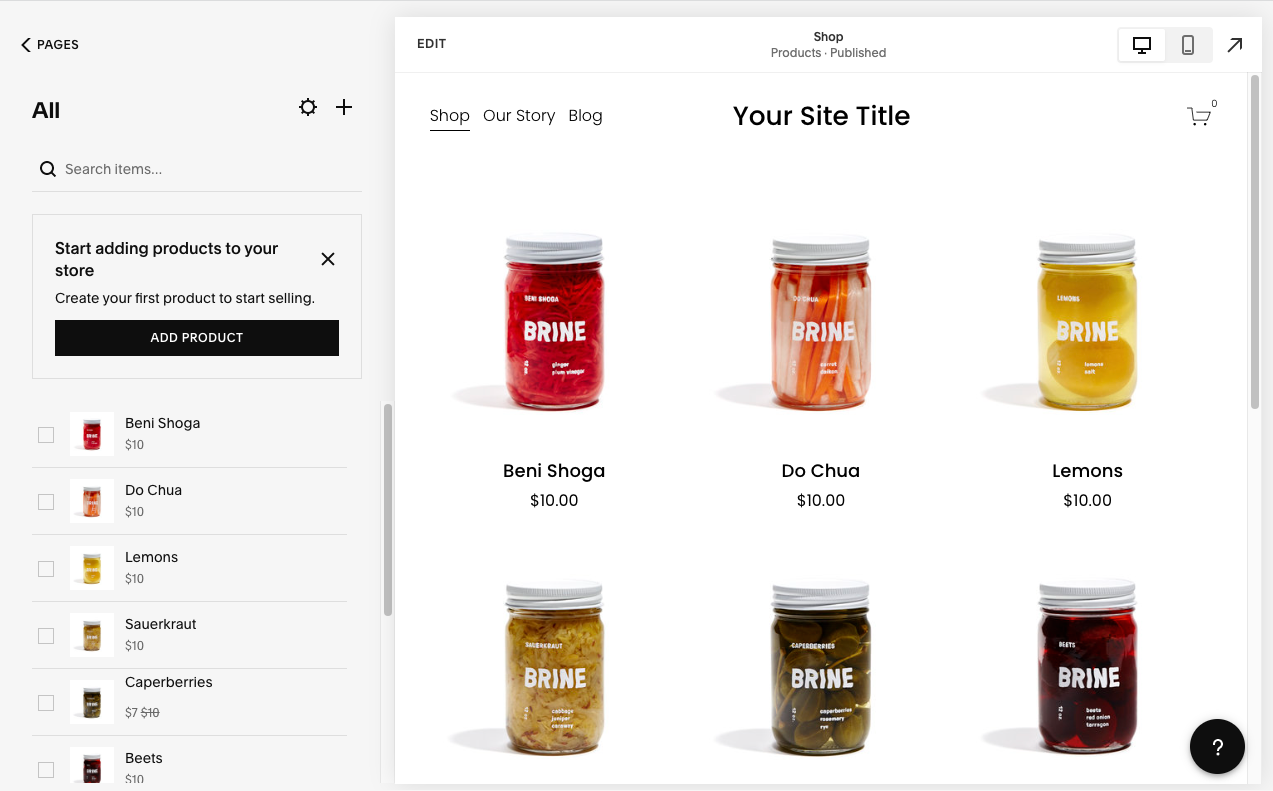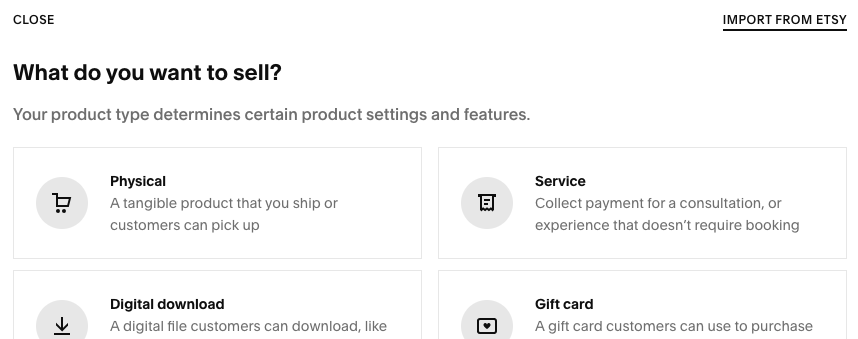As a child of the 2000s, I have firsthand horror stories about what it used to take to make even the most rudimentary website. I grappled with (and lost to) dinosaurs like Macromedia Dreamweaver, and I remember knowing with certainty that I was never going to become a web creator. But today, the hardest part of building a website isn't the construction itself—it's choosing the platform with which to build it.
Two of the most popular and powerful drag-and-drop website builders, particularly for eCommerce sellers, are Shopify and Squarespace. After spending time developing test sites with both platforms, I put together this guide to help you determine which website builder best fits your needs.
Shopify vs. Squarespace at a glance
Let's just call a spade a spade: if you're considering Shopify or Squarespace, the first thing you should know is that they're designed for different things. Shopify is designed for eCommerce sellers to create functional online storefronts, while Squarespace is a general-purpose website builder designed as much for personal use as for business selling.
| Shopify | Squarespace |
|---|---|---|
Pricing | ⭐⭐⭐⭐ Generally more expensive than Squarespace, but offers a wider suite of tools and features for your money | ⭐⭐⭐⭐ Cheaper than Shopify, but with fewer eCommerce features and more varied pricing packages |
eCommerce capabilities | ⭐⭐⭐⭐⭐ Sellers could operate long-term using the comprehensive tools included in Basic plan; mid-range plan adds better reporting capabilities and automated workflows | ⭐⭐⭐ Basic commerce plan includes only the truly basic eCommerce necessities; users must upgrade to standard plan for access to a more comprehensive suite of tools; automation is not an option with any plan |
Content management | ⭐⭐⭐ Content management isn't the intended strength of this platform, but it does give users adequate tools to produce content with the help of some of its many integrations | ⭐⭐⭐⭐ Squarespace is content-ready out of the box with its striking templates, user-friendly coding capabilities, and intuitive UX; it just doesn't come with many options for supplementary marketing and SEO integrations |
Design | ⭐⭐⭐ Ample tools to create a professional store and site, but fewer templates and less polish than Squarespace | ⭐⭐⭐⭐⭐ Huge template library, advanced product display options, and additional apps for creating high-quality visual content |
Apps and integrations | ⭐⭐⭐⭐⭐ Massive app marketplace with thousands of sales, marketing, fulfillment, store management, and accounting integrations; integrates with Zapier | ⭐⭐⭐ Integrates with a handful of platforms and offers a short list of extensions, but nowhere near as robust as Shopify's offerings; allows custom-coded integrations |
Squarespace is more visually advanced and offers greater design options
Though Shopify is no slouch in the visuals department, Squarespace does have an edge when it comes to design. Both platforms utilize a no-code, block-based page editor that's easy to set up and edit. But the sheer number and quality of Squarespace's templates blows Shopify's pre-made designs out of the water.

I found that the process to add products was almost identical for both platforms, but Squarespace's product displays are leaps and bounds prettier than Shopify's. You can set up beautifully detailed pages for each product, add zoom or lightbox functions for photo clicks, and even upload 360° turntable images for users to rotate.

If you're a serious seller running a large-scale operation, the visual enhancements that Squarespace offers probably won't be worth sacrificing access to Shopify's more advanced eCommerce tools. But smaller businesses and solo sellers may find the trade-off worthwhile.
If you're scaling a store, Shopify offers a stronger suite of tools to do it
Both Shopify and Squarespace provide all of the tools you need to run an eCommerce store, but Shopify provides the tools you need to run one really well. Shopify shines in areas that make clear that it was built by people who know what it takes to do eCommerce.
Sales: From your Shopify home base, you can integrate directly with other sales channels and sell via Facebook Marketplace, Instagram Ads, TikTok Ads, and even Amazon and Walmart.
Payments: Shopify works with a long list of payment gateways, including the usual suspects like Apple Pay and PayPal, pay-later platforms like Affirm and Klarna, and even international and crypto-based payment systems. Squarespace, on the other hand, only works with PayPal, Stripe, Square, and Apple Pay.
Shipping: With direct USPS, UPS, DHL, and dropshipping integrations, Shopify allows sellers to calculate carrier rates, print labels, and take advantage of major shipping discounts all within the platform. Squarespace's basic packages have enough of this functionality to satisfy lower-volume sellers, but they're not as scalable.
In-person selling: Shopify has its own point-of-sale system with transaction rates that are lower than what you get with Squarespace, which only offers point-of-sale capabilities via Square.

These differences probably won't matter quite as much to those who are just starting out or who are running a smaller, more basic business on the side; it's primarily those with an eCommerce focus who are aiming to scale who will really lean heavily on Shopify's additional features and tools.
Shopify also integrates with more applications
There's not much competition here—when it comes to integrations, Shopify's got the goods to help you sell yours. Shopify's app store runs several thousand apps deep and includes everything from social sales platforms like TikTok to loyalty programs like Rise.ai to customer experience products like Wonderment to sales apps for processes like abandoned cart automation and dropshipping.

Squarespace's official integrations number in the dozens, further supplemented by another few dozen third-party extensions. A lot of the major players are all there, like PayPal, Dropbox, Twitter, Google Search Console, and even Zapier, but users who lean hard on third-party applications will definitely notice the lack.
If this isn't enough integrability (a word I was not confident was a real word), premium users can implement custom code-based integrations. Clean functionality of custom integrations isn't guaranteed, and since it falls outside of Squarespace's support scope, you'll be on your own if things don't go as planned with your code. Common code customizations include integrations with applications like Etsy, Eventbrite, and AdSense, but the possibilities are (at least theoretically) wide open.
Both platforms come with strong sales tools out of the box, but for different types of users
In keeping with the theme, Shopify offers more functionality in its sales and marketing tools, while the ads and marketing materials you create with Squarespace will be markedly more beautiful.
Shopify has a big leg up on Squarespace since it allows you to sell on other marketplaces and sales channels like Facebook, Google, Pinterest, TikTok, and Instagram—all without installing any additional integrations or apps. Putting your products in more stores is going to lead to a natural increase in sales and brand awareness. The Shopify app marketplace offers thousands of hyper-specific sales and marketing tools, like pop-up ads and forms, spin-to-win widgets, reviews and loyalty programs, a slew of fulfillment and inventory managers, and more.
Functionally, Squarespace's sales tools are more limited. It integrates with Amazon, but only for tracking purposes; you can't sell there directly from your Squarespace store. Squarespace's commerce platform is set up to help users position their business to sell on various platforms and even allows sellers to import products directly from an Etsy store, but it just doesn't have the same native functionality for actually reaching those platforms that Shopify does.

The Facebook and Instagram integration allows users to sell and advertise via stories, posts, and shops, but those are the only social sales integrations as of this writing. On the fulfillment side, the integrations only include FedEx, UPS, and USPS. On the ads side, the platform only integrates with Mailchimp and Google Ads (plus AdSense via custom coding), while its Meta Pixel integration can help get more targeted advertising by tracking visitor activity.
Squarespace has better content management capabilities
With its roots planted in website creation rather than eCommerce, it seems clear that Squarespace caters to bloggers, content producers, artists, and professionals who need a visually appealing online presence. Shopify's posting and editing capabilities are fairly simple and completely capable, but it's not a strength of the platform the way it is for Squarespace. Content posting and management feels like Squarespace's natural habitat, whereas it feels like just one element of Shopify's.
Squarespace's built-in SEO tools are decent enough for general users, including integrated Google Analytics, a dedicated keyword search tool, and a handy live SERP listing preview. Shopify's SEO tools aren't as conveniently woven into the platform itself, but users in need of content marketing assistance can look to integrations with third parties like Semrush, Ahrefs, MozBar, and WordStream.
Squarespace also has a supplementary app called Unfold that provides photo and editing tools for sellers and social media creators to design beautiful social and on-site marketing materials.

The app has templates for social posts and stories as well as highly aesthetic Linktree-style bio sites that can be used to collect all of a seller's various profiles and links. What it lacks, though, is tools to implement those marketing materials strategically and leverage them for sales.
Squarespace's pricing is accessible for a wider range of users
When deciding between Shopify vs. Squarespace, price is an obvious factor to consider. At $65 per month, Squarespace's premium offering (the Commerce Advanced package) is just a notch above Shopify's bottom-tier Basic package, which comes in at $39 per month. These pricing structure differences feel like a microcosm of how the two platforms differ.
Squarespace is a simple, versatile entry point for just about anyone to create a website for any reason, backloading all the biggest eCommerce functionality into its highest (but still very affordable) tier. It's worth noting that it also offers an enterprise option with features like custom website production, one-on-one SEO sessions, unlimited website creation, and even an internal intranet site. Enterprise pricing isn't stated, but it seems like a lot of the value for this option comes from connecting a more expansive account with professional guidance.
Meanwhile, Shopify has basic eCommerce features like payment processing and shipping management packed into its lowest tier, but also offers a more enterprise-level package at $2,000 per month for "high-volume businesses." Where Squarespace's packages bump up pretty gradually in price, Shopify's take big jumps. The Shopify mid-tier goes up to $105 per month, and the Advanced tier peaks at $399 per month, with each being incentivized by more staff accounts, better reporting capabilities, and lower credit card fees.
Overall, independent sellers and small businesses can probably get what they need from one of Squarespace's four packages or Shopify's Basic offering. Bigger sales operations might find that Squarespace's commerce capabilities aren't going to cut it, making Shopify's more expensive tiers an easy choice.
Shopify vs. Squarespace: which should you choose?
Which platform you choose depends entirely on which features are most important to you. If you want a powerhouse eCommerce platform, you're going to want to go with Shopify. If you're more interested in cultivating a beautiful website experience and can live with slightly more limited sales and marketing tools, Squarespace is for you. (But if automating sales processes with Zapier is a dealbreaker for you, only Shopify offers that integration as of now.)
Once you've chosen, take a look at our guides on how to get the most out of each platform:
This article was originally published in July 2022 and has since been updated with contributions from Bryce Emley. The most recent update was in April 2023.






